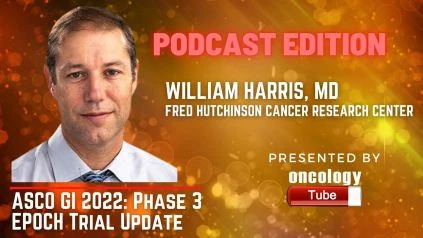William Harris, MD, Associate Professor, Clinical Research Division at Fred Hutchinson Cancer Research Center. In this video, he speaks about the ASCO GI 2022 Abstract – Radioembolization with chemotherapy for liver-dominant colorectal cancer: Analysis of patient subgroups in the EPOCH trial.
Origins:
In patients with liver-dominant metastatic colorectal illness, the EPOCH study compared the benefits of second-line transarterial radioembolization (TARE) plus chemotherapy to chemotherapy alone (mCRC). Additional EPOCH depth and duration of response (DoR), progression-free survival (PFS), and hepatic progression-free survival (hPFS) subgroup studies are included here.
Methodologies:
EPOCH was a randomized, open-label, worldwide, multicenter phase 3 trial comparing results from chemotherapy with or without unilobar or same-day bilobar TARE treatment utilizing glass microspheres for liver-dominant mCRC. PFS and hPFS were the primary study outcomes. PFS and hPFS were analyzed in pre-specified subgroups. Blinded, independent central review using RECIST 1.1 determined PFS, hPFS, DoR for patients with objective response, and depth of response (percent change from baseline to nadir in sum of longest diameters of target lesions). TheraSphere was used in the trial in the United States under FDA’s Investigational Device Exemption.
Findings:
The EPOCH research met both the primary objectives of PFS (HR = 0.69, 95 percent CI: 0.54, 0.88; 1-sided p=0.0013) and hPFS (HR = 0.59, 95 percent CI: 0.46, 0.77; 1-sided p0.0001). By Kaplan-Meier analysis, the median DoR in the 73 TARE responders was 7.2 months, compared to 6.6 months in the 45 chemotherapy alone responders (HR = 0.79, 95 percent CI: 0.48, 1.30; 1-sided p = 0.178). In the TARE arm with data available (N=196), the mean depth of response was -25.6 percent, compared to -13.0 percent in the chemotherapy only arm (N=182; mean difference -12.6 percentage points; 95 percent CI: -18.9, -6.3; 1-sided p = 0.0001). The following are the key subgroups of interest that exhibited better PFS and/or hPFS in the TARE arm (ie, 95 percent CI for HR completely below 1):
Outcomes:
Based on improved PFS and hPFS across the board and in a number of subgroups, these findings show that liver-dominant mCRC patients in this trial benefited from a combination of TARE plus chemotherapy in second-line treatment. When TARE is added to chemotherapy, the depth of response is improved compared to chemotherapy alone. NCT01483027 is the number for the clinical trial.

